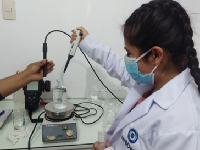Improvement of the precision in the measurement of pH in low conductivity waters by the addition of neutral electrolytes – Cajamarca, 2020
DOI:
https://doi.org/10.51252/reacae.v2i2.592Keywords:
Low conductivity, stability, neutral electrolytes, precisionAbstract
The present investigation was developed with the objective of determining the improvement in the precision of the pH measurement in low conductivity waters by the addition of neutral electrolytes, for this, tests were carried out with deionized water for pH 3 to pH 11, at starting from the standard solutions of HCl and NaOH at 0.1 M and later adding the neutral electrolytes (KCl and NaCl), thus measuring the pH, the conductivity and the time it takes to stabilize. The study has a quantitative approach, with a correlational-experimental design. The results showed that the stability time is improved with the addition of neutral electrolytes, having a time of: 91s for 0 uS/cm, 52s for 50 uS/cm, 30s for 100 uS/cm and 21 s for 200 uS/cm. cm. In conclusion, the addition of neutral electrolytes helps decrease the stability time in pH measurement, being 200uS/cm the most effective conductivity for pH measurement.
Downloads
References
APA. (2017). Standard methods for the examination of water and wastewater. American Psychological Association. https://www.standardmethods.org/
Bouaroudj, S., Menad, A., Bounamous, A., Ali-Khodja, H., Gherib, A., Weigel, D. E., & Chenchouni, H. (2019). Assessment of water quality at the largest dam in Algeria (Beni Haroun Dam) and effects of irrigation on soil characteristics of agricultural lands. Chemosphere, 219, 76–88. https://doi.org/10.1016/j.chemosphere.2018.11.193
Cakmak, E. K., Ugurlu, A., & Anbaroglu, B. (2021). Adopting citizen science approach for water quality monitoring in Uzungöl, Turkey. Environmental Monitoring and Assessment, 193(9), 604. https://doi.org/10.1007/s10661-021-09395-2
Chen, K., Chen, H., Zhou, C., Huang, Y., Qi, X., Shen, R., Liu, F., Zuo, M., Zou, X., Wang, J., Zhang, Y., Chen, D., Chen, X., Deng, Y., & Ren, H. (2020). Comparative analysis of surface water quality prediction performance and identification of key water parameters using different machine learning models based on big data. Water Research, 171, 115454. https://doi.org/10.1016/J.WATRES.2019.115454
Covington, A. K., Whalley, P. D., & Davison, W. (1985). Recommendations for the determination of ph in low ionic strength fresh waters. Pure and Applied Chemistry, 57(6), 877–886. https://doi.org/10.1351/PAC198557060877/MACHINEREADABLECITATION/RIS
Grochowska, J. (2020). Assessment of Water Buffer Capacity of Two Morphometrically Different, Degraded, Urban Lakes. Water, 12(5), 1512. https://doi.org/10.3390/w12051512
Kanoun, O., Lazarević-Pašti, T., Pašti, I., Nasraoui, S., Talbi, M., Brahem, A., Adiraju, A., Sheremet, E., Rodriguez, R. D., Ben Ali, M., & Al-Hamry, A. (2021). A Review of Nanocomposite-Modified Electrochemical Sensors for Water Quality Monitoring. Sensors, 21(12), 4131. https://doi.org/10.3390/s21124131
Liu, S., Butman, D. E., & Raymond, P. A. (2020). Evaluating CO2 calculation error from organic alkalinity and pH measurement error in low ionic strength freshwaters. Limnology and Oceanography: Methods, 18(10), 606–622. https://doi.org/10.1002/lom3.10388
Ma, J., Shu, H., Yang, B., Byrne, R. H., & Yuan, D. (2019). Spectrophotometric determination of pH and carbonate ion concentrations in seawater: Choices, constraints and consequences. Analytica Chimica Acta, 1081, 18–31. https://doi.org/10.1016/j.aca.2019.06.024
Saalidong, B. M., Aram, S. A., Otu, S., & Lartey, P. O. (2022). Examining the dynamics of the relationship between water pH and other water quality parameters in ground and surface water systems. PLOS ONE, 17(1), e0262117. https://doi.org/10.1371/journal.pone.0262117
Villasana, Y., Moradi, N., Navas‐Cárdenas, C., & Patience, G. S. (2022). Experimental methods in chemical engineering: pH. The Canadian Journal of Chemical Engineering, 100(8), 1703–1717. https://doi.org/10.1002/cjce.24393

Published
How to Cite
Issue
Section
License
Copyright (c) 2023 Danny Fernando Pérez-Tucto, Yuri Lisbeth Ventura-Zuloeta , Persi Vera-Zelada

This work is licensed under a Creative Commons Attribution 4.0 International License.
The authors retain their rights:
a. The authors retain their trademark and patent rights, as well as any process or procedure described in the article.
b. The authors retain the right to share, copy, distribute, execute and publicly communicate the article published in the Revista Amazónica de Ciencias Ambientales y Ecológicas (REACAE) (for example, place it in an institutional repository or publish it in a book), with an acknowledgment of its initial publication in the REACAE.
c. Authors retain the right to make a subsequent publication of their work, to use the article or any part of it (for example: a compilation of their works, notes for conferences, thesis, or for a book), provided that they indicate the source of publication (authors of the work, journal, volume, number and date).



